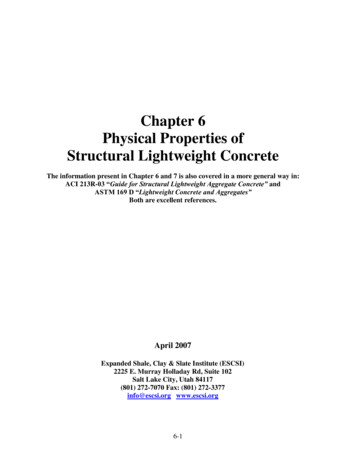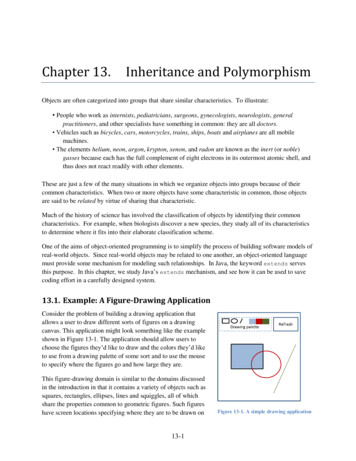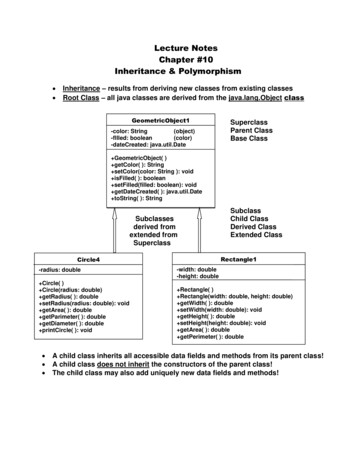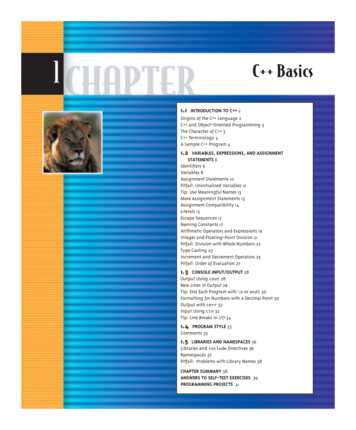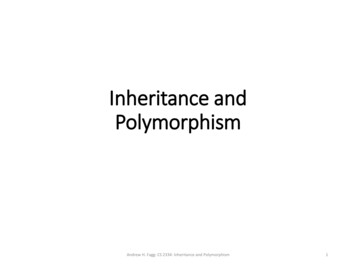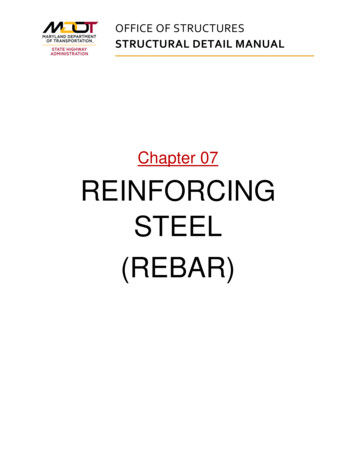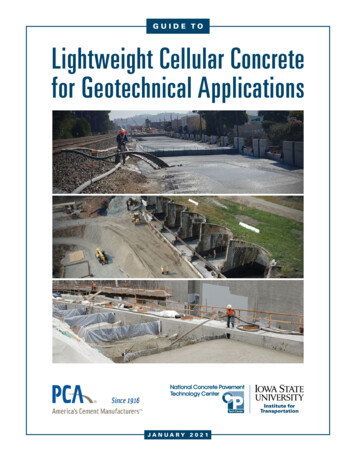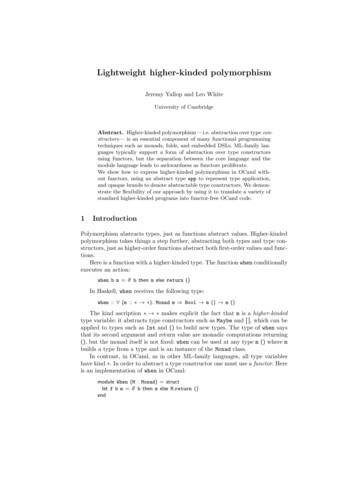
Transcription
Lightweight higher-kinded polymorphismJeremy Yallop and Leo WhiteUniversity of CambridgeAbstract. Higher-kinded polymorphism —i.e. abstraction over type constructors— is an essential component of many functional programmingtechniques such as monads, folds, and embedded DSLs. ML-family languages typically support a form of abstraction over type constructorsusing functors, but the separation between the core language and themodule language leads to awkwardness as functors proliferate.We show how to express higher-kinded polymorphism in OCaml without functors, using an abstract type app to represent type application,and opaque brands to denote abstractable type constructors. We demonstrate the flexibility of our approach by using it to translate a variety ofstandard higher-kinded programs into functor-free OCaml code.1IntroductionPolymorphism abstracts types, just as functions abstract values. Higher-kindedpolymorphism takes things a step further, abstracting both types and type constructors, just as higher-order functions abstract both first-order values and functions.Here is a function with a higher-kinded type. The function when conditionallyexecutes an action:when b m if b then m else return ()In Haskell, when receives the following type:when :: (m :: ). Monad m Bool m () m ()The kind ascription makes explicit the fact that m is a higher-kindedtype variable: it abstracts type constructors such as Maybe and [ ], which can beapplied to types such as Int and () to build new types. The type of when saysthat its second argument and return value are monadic computations returning(), but the monad itself is not fixed: when can be used at any type m () where mbuilds a type from a type and is an instance of the Monad class.In contrast, in OCaml, as in other ML-family languages, all type variableshave kind . In order to abstract a type constructor one must use a functor. Hereis an implementation of when in OCaml:module When (M : Monad) structlet f b m if b then m else M.return ()end
The When functor receives the following type:module When (M : Monad) :sigval f : bool unit M.t unit M.tendDefining When is more work in OCaml than in Haskell. For callers of Whenthe difference is even more pronounced. Here is a Haskell definition of unlessusing when:unless b m when (not b) mDefining Unless in OCaml involves binding three modules. First, we definea functor to abstract the monad once more, binding both the functor and itsargument. Next, we instantiate the When functor with the monad implementationand bind the result. Finally, we can call the function:module Unless(M : Monad) structmodule W When(M)let f b m W.f (not b) mendThe situation is similar when we come to use our functions at a particularmonad. We must first instantiate When or Unless with a module satisfying theMonad interface before we can use it to build computations. The following example instantiates Unless with a module implementing the state monad, thenuses the result to build a computation that conditionally writes a value:let module U Unless(StateM) inU.unless (v 0) (StateM.put v)Why does OCaml require us to do so much work to define such simple functions? One issue is the lack of overloading: in order to use functions like whenwith multiple monads we must explicitly pass around dictionaries of functions.However, most of the syntactic heaviness comes from the lack of higher-kindedpolymorphism: functors are the only mechanism ML provides for abstractingover type constructors. The purpose of this paper is to address this second issue,bringing higher-kinded polymorphism into the core OCaml language, and making it almost as convenient to define when and unless in OCaml as in Haskell.1.1The alias problemAt this point the reader might wonder why we do not simply adopt the Haskellapproach of adding higher-kinded polymorphism directly to the core language.The answer lies in a fundamental difference between type constructors in Haskelland type constructors in OCaml.In Haskell data and newtype definitions create fresh data types. It is possibleto hide the data constructors of such types by leaving them out of the export listof the defining module, but the association between a type name and the datatype it denotes cannot be abstracted. It is therefore straightforward for the type
checker to determine whether two type names denote the same data type: afterexpanding synonyms, type names denote the same data types exactly when thenames themselves are the same.OCaml provides more flexible mechanisms for creating abstract types. Anentry type t in a signature may hide either a fresh data type definition such astype t T of int or as an alias such as type t int. Abstracting types withsignatures is sometimes only temporary, since instantiating a functor can replaceabstract types in the argument signature with concrete representations. Checkingwhether two type names denote the same data type is therefore a more subtlematter in OCaml than in Haskell, since abstract types with no visible equalitiesmay later turn out to be equal after all.Since OCaml cannot distinguish between data types and aliases, it must support instantiating type variables with either. This works well for type variablesof base kind, but breaks down with the addition of higher-kinded type variables. To see the difficulty, consider the unification of the following pair of typeexpressions’a ’f (int * int) listwhere ’f is a higher-kinded type variable. If there are no other definitions inscope then there is an obvious solution, unifying ’a with (int * int) and ’fwith list. Now suppose that we also have the following type aliases in scope:type ’a plist (’a * ’a) listtype ’a iplist (int * int) listWith the addition of plist and iplist there is no longer a most general unifier.Unifying ’f with either plist or iplist gives two new valid solutions, and noneof the available solutions is more general than the others.One possible response to the loss of most general unifiers is to give up ontype inference for higher-kinded polymorphism. This is the approach taken byOCaml’s functors, which avoid ambiguity by explicitly annotating every instantiation. We will now consider an alternative approach that avoids the need toannotate instantiations, bringing higher-kinded polymorphism directly into thecore language.1.2DefunctionalizationSince we cannot use higher-kinded type variables to represent OCaml type constructors, we are faced with the problem of abstracting over type expressions ofhigher kind in a language where all type variables have base kind. At first sightthe problem might appear intractable: how can we embed an expressive objectlanguage in a less expressive host language?Happily, there is a well-understood variant of this problem from which wecan draw inspiration. Four decades ago John Reynolds introduced defunctionalization, a technique for translating higher-order programs into a first-orderlanguage [Reynolds, 1972].
The following example illustrates the defunctionalization transform. Here isa higher-order ML program which computes a sum and increments a list ofnumbers:let rec fold : type a b. (a b b) b a list b fun (f, u, l) match l with [] u x :: xs f (x, fold (f u, xs))let sum l fold ((fun (x, y) x y), 0, l)let add (n, l) fold (fun (x, l’) x n :: l’) [ ] lDefunctionalizing this program involves introducing a datatype arrow withtwo constructors, one for each of the two function terms; the arguments to eachconstructor represent the free variables of the corresponding function term, andthe type parameters to arrow represent the argument and return types of thefunction. We follow Pottier and Gauthier [2004] in defining arrow as a generalised algebraic data type (GADT), which allows the instantiation of the typeparameters to vary with each constructor, and so makes it possible to preservethe well-typedness of the source program.type ( , ) arrow Fn plus : ((int int), int) arrow Fn plus cons : int ((int int list), int list) arrowThe second step introduces a function, apply, that relates each constructorof arrow to the function body.let apply : type a b. (a, b) arrow a b fun (appl, v) match appl with Fn plus let (x, y) v in x y Fn plus cons n let (x, l’) v in x n :: l’We can now replace function terms with constructors of arrow and indirectcalls with applications of apply to turn the higher-order example into a firstorder program:let rec fold : type a b. (a b, b) arrow b a list b fun (f, u, l) match l with [] u x :: xs apply (f, (x, fold (f, u, xs)))let sum l fold (Fn plus, 0, l)let add (n, l) fold (Fn plus cons n, [ ], l)1.3Type defunctionalizationDefunctionalization transforms a program with higher-order values into a program where all values are first-order. Similarly, we can change a program with
higher-kinded type expressions into a program where all type expressions are ofkind , the kind of types.The first step is to introduce an abstract type constructor, analogous toapply, for representing type-level application:type (’a, ’f) appOCaml excludes higher-kinded type expressions syntactically by requiringthat the type operator be a concrete name: ’a list is a valid type expression,but ’a ’f is not. The app type sidesteps the restriction, much as the applyfunction makes it possible to embed the application of a higher-order function ina first-order defunctionalized program. The type expression (s, t) app representsthe application of the type expression t to the type expression s. We can nowabstract over type constructors by using a type variable for the operator termt.Eliminating higher-order functions associates a constructor of arrow witheach function expression from the original program. In order to eliminate higherkinded type expressions we associate each type expression with a distinct instantiation of app. More precisely, for each type constructor t which we wish to usein a polymorphic context we introduce an uninhabited opaque type T.t, calledthe brand. Brands appear as the operator argument to app; for example, we canrepresent the type expression ’a list as (’a, List.t) app, where List.t is thebrand for list. With each brand we associate injection and projection functionsfor moving between the concrete type and the corresponding instantiation ofapp:module List : sigtype tval inj : ’a list (’a, t) appval prj : (’a, t) app ’a listendWe now have the operations we need to build and call functions that abstractover type constructors. Here is a second OCaml implementation of the whenfunction from the beginning of this paper:1let when (d :#monad) b m if b then m else d#return ()The first parameter d is a dictionary of monad operations analogous to thetype class dictionary passed to when in a typical implementation of Haskell [Wadlerand Blott, 1989]. (We defer further discussion of dictionary representation toSection 2.3.) Our earlier implementation received the dictionary as a functorargument in order to accommodate abstraction over the type constructor, butthe introduction of app makes it possible to write when entirely within the corelanguage. This second implementation of when receives the following type:val when : ’m #monad bool (unit, ’m) app (unit, ’m) app1We append an underscore to variable names where they clash with OCaml keywords.
type (’a, ’f) appmodule type Newtype1 sigtype ’a stype tval inj : ’a s (’a,t) appval prj : (’a,t) app ’a sendmodule type Newtype2 sigtype (’a, ’b) stype tval inj : (’a,’b) s (’b,(’a,t) app) appval prj : (’b,(’a,t) app) app (’a,’b) sendmodule Newtype1(T : sig type ’a t end):Newtype1 with type ’a s ’a T.tmodule Newtype2(T : sig type (’a,’b) t end):Newtype2 with type (’a,’b) s (’a,’b) T.tFig. 1. The higher interfaceFig. 2. The Newtype2 functorThe improvement becomes even clearer when we implement unless withouta functor in sight:let unless d b m when d (not b) mThere is a similar improvement when using when and unless at particularmonads. Once again we find that we no longer need to instantiate a functor,since the dictionary parameter is passed as a regular function argument. Here isour earlier example that conditionally writes a value in the state monad, adaptedto our new setting:unless state (v 0) (state#put v)2The interfaceWe have written a tiny library called higher to support programming with app.Figure 1 shows the interface of the higher library.2 The Newtype1 functor generates brands together with their associated injection and projection functions,preserving the underlying concrete type under the name s for convenience. Forexample, applying Newtype1 to a structure containing the concrete list typegives the List.t brand from Section 1.3.module List Newtype1(struct type ’a t ’a list end)In fact, as the numeric suffix in the Newtype1 name suggests, higher exportsa family of functors for building brands. Figure 2 gives another instance, forconcrete types with two parameters. However, rather than introducing a secondversion of app to accompany Newtype2, we use app in a curried style. One of thebenefits of higher kinded polymorphism is the ability to partially apply multiparameter type constructors, and the currying in Newtype2 makes this possiblein our setting.2The higher library is available on opam: opam install higher
The remainder of this section shows how various examples from the literaturecan be implemented using higher.2.1Example: higher-kinded foldsHigher-kinded polymorphism was introduced to Haskell to support constructorclasses such as Monad [Jones, 1995, Hudak et al., 2007]. However, not all usesof higher kinds involve constructor classes. Traversals of non-regular datatypes(whose definitions contain non-trivial instantiations of the definiendum) typically involve higher-kinded polymorphism. Here is an example: the type perfectdescribes perfectly balanced trees, with 2n elements:type ’a perfect Zero of ’a Succ of (’a ’a) perfectA fold over a perfect value is parameterised by two functions, zero, appliedat each occurrence of Zero, and succ, applied at each occurrence of Succ. Indiagram form the fold has the following simple shape:Succ (Succ . . . (Succ (Zero v)). . .) succ (succ . . . (succ (zero v)). . .)What distinguishes this fold from a similar function defined on a regulardatatype is that each occurrence of Succ is used at a different type. If the outermost constructor builds an int perfect value then the next constructor buildsan (int int) perfect, the next an ((int int) (int int)) perfect, andso on. For maximum generality, therefore, we must allow the types of zero andsucc to vary in the same way.3 In Haskell we might define foldp as follows:foldp :: ( a. a f a) ( a. f (a, a) f a) Perfect a f afoldp zero succ (Zero l) zero lfoldp zero succ (Succ p) succ (foldp zero succ p)Here is a corresponding definition in OCaml, using a record type with polymorphic fields for the higher-rank types (nested quantification) and using appto introduce higher-kinded polymorphism:type ’f perfect folder {zero: ’a. ’a (’a, ’f) app;succ: ’a. (’a ’a, ’f) app (’a, ’f) app;}let rec foldp : ’f ’a. ’f perfect folder ’a perfect (’a, ’f) app fun { zero; succ } function Zero l zero l Succ p succ (foldp { zero; succ } p)3Hinze [2000] shows how to take generalization of folds over nested types significantlyfurther than the implementation we present here.
type (’a, ’b) eqmodule Eq : Newtype2type (’a, ’b) eq (’b, (’a, Eq.t) app) appval refl : unit (’a, ’a) eqval refl : unit (’a, ’a) eqmodule Subst (F : sig type ’a f end):sigval subst : (’a, ’b) eq ’a F.f ’b F.fendFig. 3. Leibniz equality without higherval subst : (’a, ’b) eq (’a, ’f) app (’b, ’f) appFig. 4. Leibniz equality with higherThe foldp function has a number of useful properties. A simple one, immediately apparent from the diagram, is that foldp Zero Succ is the identity. Inorder to instantiate the result type we need a suitable instance of app, which wecan obtain using Newtype1.module Perfect Newtype1(struct type ’a t ’a perfect end)Passing Zero and Succ requires a little massaging with inj and prj.let idp p Perfect.(prj (foldp { zero (fun l inj (Zero l));succ (fun b inj (Succ (prj b)))} p))It is easy to verify that idp implements the identity function.2.2Example: Leibniz equalityOur second example involves higher-kinded polymorphism in the definition of adatatype. As part of a library for dynamic typing, Baars and Swierstra [2002]introduce the following definition of type equality:newtype Equal a b Equal ( (f :: ). f a f b)The variable f abstracts over one-hole type contexts — type expressionswhich build a type from a type. The types encode Leibniz’s law that a and bcan be considered equal if they are interchangeable in any context f. A value oftype Equal a b serves both as proof that a and b are equal and as a coercionbetween contexts instantiated with a and b. Ignoring values, there is a singleinhabitant of Equal, the value Equal id of type Equal a a, which serves as aproof of equality between any type a and itself.Yallop and Kiselyov [2010] show how first-class modules make it possible todefine an OCaml type eq equivalent to Equal. A minimised version of eq and itscore operations is given in Figure 3. There are two operations: refl introducesthe sole inhabitant, a proof of reflexive equality, and subst turns an equalityproof into a coercion within any context f.
class virtual [’m] monad : objectmethod virtual return : ’a. ’a (’a, ’m) appmethod virtual bind : ’a ’b. (’a, ’m) app (’a (’b, ’m) app) (’b, ’m) appendFig. 5. The monad interface in OCamltype (’a, ’f) free Return of ’a Wrap of ((’a, ’f) free, ’f) appmodule Free Newtype2(struct type (’a, ’f) t (’a, ’f) free end)Fig. 6. The free monad data type in OCamlFigure 4 gives a second definition of eq and its operations using higher. Aswith unless, using the functor version of Figure 3 is significantly heavier thanthe higher version of Figure 4. Here is a definition of the transitive property ofequality using the implementation of Figure 3:let trans : type a b c. (a, b) eq (b, c) eq (a, c) eq fun ab bc let module S Subst(struct type ’a tc (a, ’a) eq end) inS.subst bc abAnd here is a definition using higher :let trans ab bc subst bc abBoth implementations receive the same type:val trans: (’a, ’b) eq (’b, ’c) eq (’a, ’c) eqThe contrast between the implementations of refl and subst is similarlystriking. The interested reader can find the full implementations in the extendedversion of this paper.2.3Example: the codensity transformMuch of the appeal of higher-kinded polymorphism arises from the ability to define overloaded functions involving higher-kinded types. Constructor classes [Jones,1995] turn monads (and other approaches to describing computation such as arrows [Hughes, 2000] and applicative functors [Mcbride and Paterson, 2008]) fromdesign patterns into named program entities. The Monad interface requires abstraction over type constructors, and hence higher kinds, but defining it bringsa slew of benefits: it becomes possible to build polymorphic functions and notation which work for any monad, and to construct a hierarchy of related interfacessuch as Functor and MonadPlus.OCaml does not currently support overloading, making many programs whichfind convenient expression in Haskell cumbersome to write. However, the loss ofelegance does not arise from a loss of expressive power: although type classes are
let monad free (functor free : ’f #functor ) objectinherit [(’f, Free.t) app] monadmethod return v Free.inj (Return v)method bind let rec bind m k match m with Return a k a Wrap t Wrap (functor free#fmap (fun m bind m k) t) infun m k Free.inj (bind (Free.prj m) (fun a Free.prj (k a)))endFig. 7. The free monad instance in OCamlunavailable we can achieve similar results by programming directly in the targetlanguage of the translation which eliminates type classes in favour of dictionarypassing [Wadler and Blott, 1989]. We might reasonably view these explicit dictionaries as temporary scaffolding that will vanish once the plans to introduceoverloading to OCaml come to fruition [Chambart and Henry, 2012].We now turn to an example of a Haskell program that makes heavy useof higher-kinded overloading. The codensity transform [Voigtländer, 2008] takesadvantage of higher-kinded polymorphism to systematically substitute more efficient implementations of computations involving free monads, leading to asymptotic performance improvements. We will focus here on the constructs necessaryto support the codensity transform rather than on the computational content ofthe transform itself, which is described in Voigtländer’s paper. The code in thissection is not complete (the definitions of abs, C, and functor are missing), butwe give a complete translation of the code from Voigtländer [2008, Sections 3and 4] in the extended version of this paper.Figure 5 shows the monad interface in OCaml. We represent a type class byan OCaml virtual class —i.e., a class with methods left unimplemented. Thetype class variable m of type becomes a type parameter, which is used inthe definition of monad as an argument to our type application operator app.Figure 6 defines the free monad type [Voigtländer, 2008, Section 3]. The useof app in the definition of free reflects the fact that the type parameter ’f hashigher kind; without higher we would have to define the free within a functor.Figure 7 gives the free monad instance over a functor using the free type. Werepresent type class instances in OCaml as values of object type. Instantiatingand inheriting the monad class provides type checking for return and bind.Constraints in the instance definition in the Haskell code become arguments tothe function; our definition says that (’f, Free.t) app is an instance of monad if’f is an instance of functor.Figure 8 defines the freelike interface. In Voigtländer’s presentation FreeLikeis a multi-parameter type class with two superclasses. In our setting the parameters become type parameters of the virtual class and the superclasses becomeclass arguments which must be supplied at instantiation time. We bind the classarguments to methods so that we can easily retrieve them later.
class virtual [’f, ’m] freelike (pf : ’f functor ) (mm : ’m monad) objectmethod pf : ’f functor pfmethod mm : ’m monad mmmethod virtual wrap : ’a. ((’a, ’m) app, ’f) app (’a, ’m) appendFig. 8. The freelike interface in OCamltype (’a, ’f) freelike poly {fl: ’m ’d. ((’f, ’m) #freelike as ’d) (’a, ’m) app}let improve (d : #functor ) { fl } Free.prj (abs (monad free d) (C.prj (fl (freelike c d (freelike free d)))))Fig. 9. The improve function in OCamlimprove :: Functor f ( m. FreeLike f m m a) Free f aimprove m abs mFig. 10. The improve function in HaskellFigure 9 shows the improve function, the entry point to the codensity transform. In Haskell improve has a concise definition (Figure 10) due to the amountof work done by the type class machinery; in OCaml we must perform the workof building and passing dictionaries ourselves. As in a previous example (Section 2.1) we use a record with a polymorphic field to introduce the necessaryhigher-rank polymorphism.The extended version of this paper gives a complete implementation of thecodensity transform, and a translation of Voigtländer’s example which applies itto an echo computation.2.4Example: kind polymorphismStandard Haskell’s kind system is “simply typed”: the two kind formers are thebase kind and the kind arrow , and unknown types are defaulted to . Recentwork adds kind polymorphism, increasing the number of programs that can beexpressed [Yorgey et al., 2012]. In contrast higher lacks a kind system altogether:the brands that represent type constructors are simply uninhabited members ofthe base kind .The obvious disadvantage to the lack of a kind system is that the typechecker is no help in preventing the formation of ill-kinded expressions, suchas (List.t, List.t) app. However, this drawback is not so serious as might firstappear, since it does not introduce any means of forming ill-typed values, andso cannot lead to runtime errors. In fact, the absence of well-kindedness checks
class virtual [’f] category objectmethod virtual ident : ’a. (’a, (’a, ’f) app) appmethod virtual compose : ’a ’b ’c.(’b, (’a, ’f) app) app (’c, (’b, ’f) app) app (’c, (’a, ’f) app) appendFig. 11. The category interface.module Fun Newtype2(struct type (’a, ’b) t ’b ’a end)let category fun objectinherit [Fun.t] categorymethod ident Fun.inj idmethod compose f g Fun.inj (fun x Fun.prj g (Fun.prj f x))endFig. 12. A category instance for .type (’n, ’m) ip { ip: ’a. (’a, ’m) app (’a, ’n) app }module Ip Newtype2(struct type (’n, ’m) t (’n, ’m) ip end)let category ip objectinherit [Ip.t] categorymethod ident Ip.inj { ip id }method compose f g Ip.inj {ip fun x (Ip.prj g).ip ((Ip.prj f).ip x) }endFig. 13. A category instance for index-preserving functions.can be used to advantage: it allows us to write programs which require the kindpolymorphism extension in Haskell.Figure 11 defines a class category parameterised by a variable ’f. In theanalogous type class definition standard Haskell would give the variable corresponding to ’f the kind ; the polymorphic kinds extension givesit κ. κ κ , allowing the arguments to be type expressions of any kind.Since there is no kind checking in higher, we can also instantiate the argumentsof ’f with expressions of any kind. Figure 12 gives an instance definition for ,whose arguments have kind ; Figure 13 adds a second instance for the categoryof index-preserving functions, leaving the kinds of the indexes unspecified.The extended version of this paper continues the example, showing howhigher supports higher-kinded non-regularity.3Implementations of higherUp to this point we have remained entirely within the OCaml language. Boththe interfaces and the examples are written using the current release of OCaml(4.01). However, running the code requires an implementation of the higherinterface, which requires a small extension to pure OCaml. We now considertwo implementations of higher, the first based on an unsafe cast and the secondbased on an extension to the OCaml language.
type family Apply f p :: *newtype App f b Inj { prj :: Apply f b }data Listtype instance Apply List a [a]Fig. 14. Implementing higher with type familiestype (’p, ’f) appmodule Newtype1 (T : sig type ’a t end) structtype ’a s ’a T.ttype tlet inj : ’a s (’a, t) app Obj.magiclet prj : (’a, t) app ’a s Obj.magicendFig. 15. Implementing higher with an unchecked castLet us return to the analogy of Section 1.3. The central point in an implementation of higher is a means of translating between values of the app familyof types and values of the corresponding concrete types, much as defunctionalization involves translating between higher-order function applications and usesof the apply function. However, defunctionalization is a whole program transformation: a single apply function handles every translated higher-order call.Since we do not wish to require that every type used with higher is known inadvance, we need an implementation that makes it possible to extend app withnew inhabitants as needed.We note in passing that Haskell’s type families [Schrijvers et al., 2008], whichdefine extensible type-level functions, provide exactly the functionality we need.Figure 14 gives an implementation, with a type family Apply parameterisedby a brand and a type and a type definition App with injection and projectionfunctions Inj and Prj. The type instance declaration adds a case to Apply thatmatches the abstract type List and produces the representation type [a].3.1First implementation: unchecked castThe first implementation is shown in Figure 15. Each instantiation of the Newtype1constructor generates a fresh type t to use as the brand. The inj and prj functions which coerce between the concrete type ’a s and the corresponding defunctionalized type (’a, t) app are implemented using the unchecked coercionfunction Obj.magic.Although we are using an unchecked coercion within the implementation ofNewtype1 the module system ensures that type safety is preserved. Each moduleto which Newtype1 is applied generates a fresh brand t. Since the only way to
type (’p, ’f) app . .module Newtype1 (T : sig type ’a t end) () structtype ’a s ’a T.ttype ttype ( , ) app App : ’a s (’a, t) applet inj v App vlet prj (App v) vendFig. 16. Implementing higher using open typescreate a value of type (’a, t) app is to apply inj to a value of the correspondingtype ’a s, it is always safe to apply prj to convert the value back to type ’a s.3.2Second implementation: open typesWe can avoid the use of an unchecked cast altogether with a small extensionto the OCaml language. Löh and Hinze [2006] propose extending Haskell withopen data types, which lift the restriction that all the constructors of a data typemust be given in a single declaration. The proposal is a good fit for OCaml,which already supports a single extensible type for exceptions, and there is animplementation available.4 .Figure 16 shows an implementation of higher using open data types. Theellipsis in the first line declares that app is an open data type; each instantiation of the Newtype1 functor extends app with a fresh GADT constructor, Appwhich instantiates app with the brand t and which carries a single value of therepresentation type ’a s. The inj and prj functions inject and project usingApp; although the pattern in prj is technically inexhaustive, the fact that thefunctor generates a fresh t for each application guarantees a match in practice.The
alised algebraic data type (GADT), which allows the instantiation of the type parameters to vary with each constructor, and so makes it possible to preserve . OCaml excludes higher-kinded type expressions syntactically by requiring that the type operator be a concrete name: 'a list is a valid type expression,
